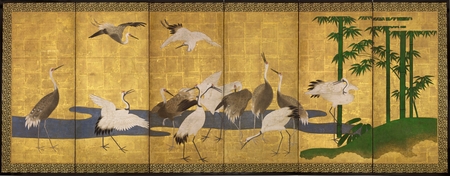Product Description
7519 A six-fold paper screen painted in ink and colour on a gold ground with take (bamboo) and a flock of tsuru (cranes) in a river landscape.
Japan 18th century Edo period
Dimensions: H. 42″ x W. 107½” (107cm x 273cm)
Tsuru (cranes) are among the premier symbols of longevity and good fortune in East Asia. For at least two millennia, the Chinese have viewed them as living to a great age and as being able to navigate between heaven and earth. In turn, these attributes have made them logical companions of sennin, the Taoist Immortals. Ancient Taoist alchemists believed that imbibing beverages made with crane eggs or tortoise shells would increase one’s vital energies. In Taoist thought and art, the crane is often paired with the tortoise, another symbol of longevity. The red-crowned, or Japanese, crane depicted in this painting is said to live for 1,000 years. The other crane depicted here is the white-naped crane, which migrates yearly to its wintering grounds in Southern Japan.
In Japan, the crane is the animal most frequently seen in the fine and applied arts. Although a common subject of painting, it is most closely associated with the New Year and with marriage ceremonies. In earlier times, when the Japanese still used circular brass mirrors and presented them on the occasion of a marriage, the crane was a favoured decorative theme due to its association with fidelity. In recent centuries, the crane has appeared on elaborately embroidered wedding kimono and among the mizuhiki (cord made from twisted paper) decorations presented at the time of betrothal.
Take (bamboo) represents strength, vitality and survival through adversity due to its delicate structure that bends in the wind, but never breaks. It has been known as one of the Shochikubai (Three Friends of Winter) since the 13th century in China, along with the plum and the pine, each symbolising perseverance and integrity as they survive the winter without withering.
An ode to bamboo:
This gentleman
Grows and grows
Most auspiciously
Learn from him and
You, too, will flourish forever.
Haiku by Otagaki Rengetsu (1791-1875) on bamboo: Written at the age of 80 (1870)






